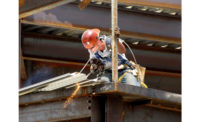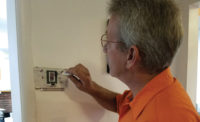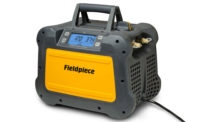Variable-speed options are abundant in HVAC and their impact has been felt industry-wide. Contractors and manufacturers alike have taken to these single- and two-stage alternatives as ways to enhance energy efficiency and drive customer intrigue.
“Variable speed plays a huge role in our company and the products we offer,” said Travis Smith, owner, Sky Heating & Air Conditioning, Portland, Oregon. “In 2016, one-fifth of all outdoor unitary products we sold were variable speed. For heat pumps alone, 65 percent of the unitary heat pumps we sold were variable speed. On the geothermal side, probably 40-50 percent were variable speed and 100 percent of the mini splits we sold were variable speed. We even heat and cool two of our three offices with variable-speed products, and I have variable-speed products in both of my homes.”
Tales like Smith’s are becoming more common throughout HVAC as variable-speed offerings continue to multiply and diversify.
“Variable-speed options have an ever-increasing role,” said Greg Crumpton, vice president of critical environments & facilities, Service Logic, Charlotte, North Carolina. “The variable-speed options, alongside the VRV-VRF options, really allow us to make the proper equipment recommendations that are best suited for the customers’ needs. Historically, the toolbox of options was/is limited, but these break-through technologies allow for such a broader view of the situation. These new technologies are especially valuable in the retrofit arena.”
According to Farooq Mohammad, director, product management, air conditioning division, Rheem Mfg. Co., during the past 10 years, manufacturers have been able to engineer more compact and cost-effective air conditioners and heat pumps that utilize variable-speed technology.
“We are now seeing more products incorporate variable-speed, which provides not only better control over home comfort but also increased efficiencies for both premium and more value-driven products,” said Mohammad.
THE TANGIBLE BENEFITS
Variable-speed technology has the obvious benefit of providing users with additional choices when it comes to running their HVAC equipment. Rather than one setting that runs at 100 percent all the time, variable-speed allows for layered, configurable settings.
However, there is much more to variable speed than may initially meet the eye.
“It is much quieter, offers cost savings, qualifies for rebates, affords greater comfort in temperature, offers humidity control or dehumidification control, and it helps to overcome some duct or home comfort issues,” said Matt Bergstrom, owner and president, Thornton and Grooms, Farmington Hills, Michigan.
Crumpton mentioned that efficiency and comfort are two major benefits to variable speed. “Efficiency can be easy to quantify while comfort is not,” he said. “[Variable speed] allows lower airflow noise when it’s not running in high speed and provides more even temperatures in the house. It also offers better zoning functioning because the heat pump modulates with the dampers, and the outdoor unit noise is now so quiet that I hear my neighbor’s a/c over the noise of my own when standing in my own backyard.”
Mohammad also touted how variable-speed compressors and the matched variable-speed indoor unit (whether furnace or indoor air handler) precisely adjust to the heating and cooling needs of the homeowner.
“The Rheem Prestige® Series variable-speed air conditioners and heat pumps deliver precise temperature settings with the ability to maintain ideal home temperatures, humidity levels, and air quality at all hours of the day, which helps to eliminate discomfort associated with periods of overcooling or overheating that happen with traditional single-stage systems,” he said.
THE CHALLENGES
As with any technology, there are both pros and cons to variable speed, with the initial price point being higher than standard one-speed offerings sometimes leading to trepidation on the part of consumers. There is also the greater technical knowledge and understanding needed in order to properly maintain and install these products.
“Many systems require laptops with specialized software or unit-specific modules to troubleshoot and repair,” said Smith. “Living in rainy Oregon, it’s difficult to walk to an outdoor unit and set up a laptop. Also, with the technology making such a leap forward from one and two stage to 750 stage, there is a lot more that can go wrong or a lot more areas of ‘Why is it doing this versus that?’ that take experience to recognize and learn.”
“These variable-speed products are highly complex and have a lot of controls,” said Brian Urlaub, commercial sales manager, Enertech Global LLC. “The level of training for technicians is much greater to be able to work on these types of products. That’s where there is some concern, because there is a market gap on technicians who can actually work on and service these products. Secondly, if something fails, you have a lot more components within the products and troubleshooting could be much harder. All of these products are of higher cost than traditional two-stage units, as well. These are all considerations that must be made when looking at variable speed.”
Crumpton also said the challenges around variable speed really come down to education and he believes that, generationally, the more seasoned engineering community has been concerned with oil entrainment.
“Lack of proper lubrication is and always will be a challenge in comperssorized systems,” he said. “Having our engineering communities coupled with an ever-increasing market that understands the technology will be a winner in the long run. This is not saying one thing negative about the engineering community, you have to understand, when an engineer stamps a drawing, that system is theirs for life. We need to ensure that the OEM’s are spending the proper time working with mechanical, electrical, plumbing firms for this specific reason.”
Another issue, as pointed out by Bergstrom, is that variable speed can easily be oversold and get confusing for customers. “The benefits are great, but variable speed is not going to fix everything,” he said. “The other issue is that there are true variable-speed motors that will fully and automatically adjust to static pressure and a home’s needs and then there is the e-motor, or variable-speed motors’ true little brother, that is an electronically commutated motor (ECM) with variable fixed-speed settings. This is a less expensive option as well a lower value option. This can be confusing to the end buyer, because they are both called variable-speed motors but offer very different levels of comfort.”
THE IMPACT CONTINUES
Variable speed is proving to be a part of the industry that is only going to become more important as time goes on. Manufacturers and contractors are quick to realize this technology’s potential has not yet been fully realized.
“I think everything will be variable speed soon,” said Smith. “Look at mini splits, I’m not even sure any of the large brands sell non-variable-speed mini splits any more. Every year, our sales of variable speed go up as a percentage. You don’t drive a car with one speed, you don’t have a TV with one channel, and you don’t have a cellphone with one number programmed in it. So, why do we live with a heat pump or a/c unit that only has one speed for infinitely variable conditions in the home?”
Driven by mid-efficiency product demands, Rheem is able to design and engineer products that utilize variable-speed technology while keeping the overall size of units small, Mohammed said. That ability will allow demand for variable-speed options to increase.
“What we’ve found in the past is that while we’re manufacturing higher efficiency products, the technology is causing the overall unit size to increase. While we improve the cost effectiveness of variable-speed technology, we also need to minimize the overall size of the HVAC units,” he said.
Urlaub painted a bright picture of what is to come for variable speed, believing it is the future of HVAC.
“As the components and units become more readily available, more products will become available and the costs could come down,” Urlaub said. “Technicians will become trained and more familiar with everything, so there isn’t such a wide gap in expertise to install and service variable-speed units. It will continue to grow and become more viable to the industry.”
Publication date: 2/6/2017
Want more HVAC industry news and information? Join The NEWS on Facebook, Twitter, and LinkedIn today!









